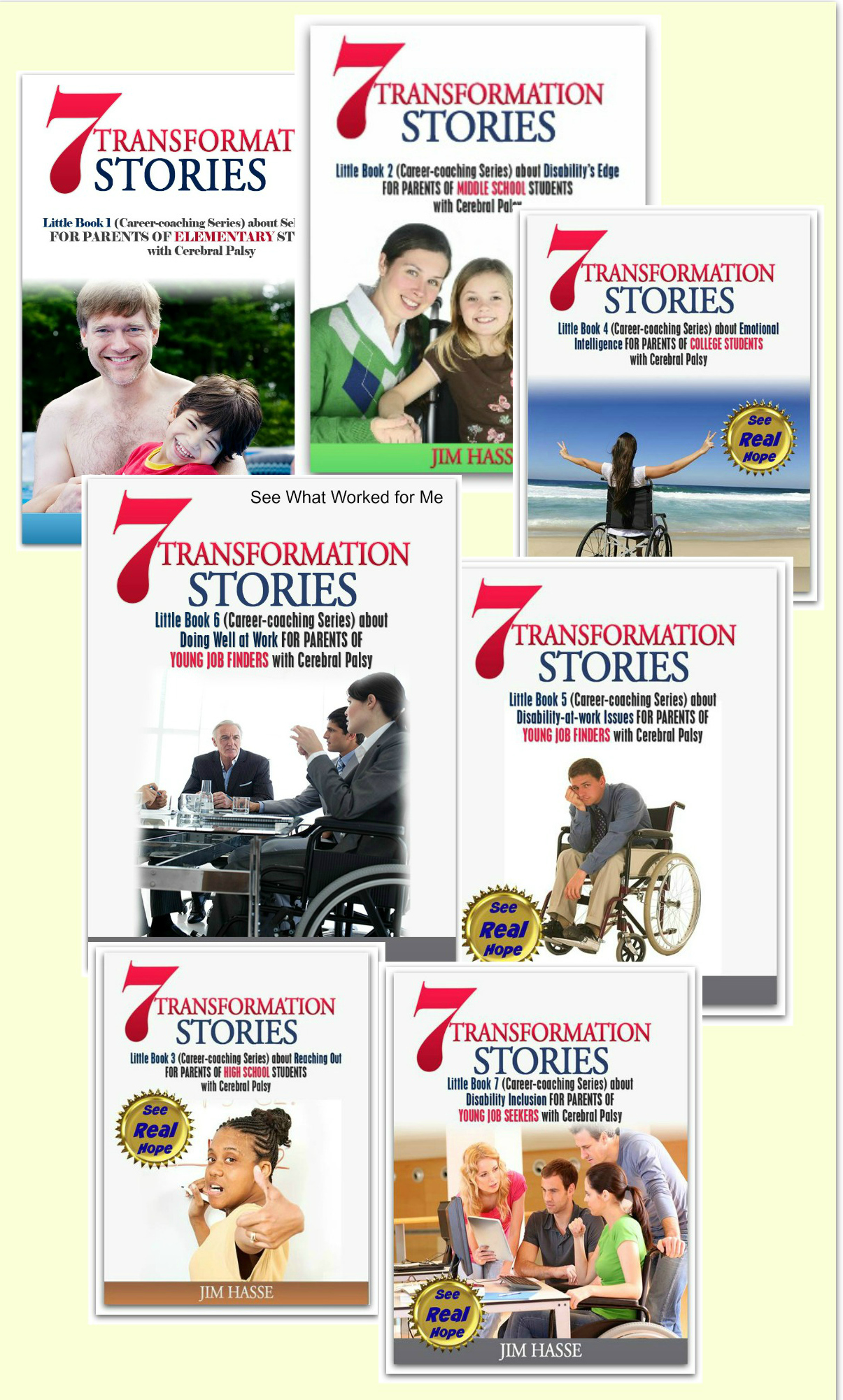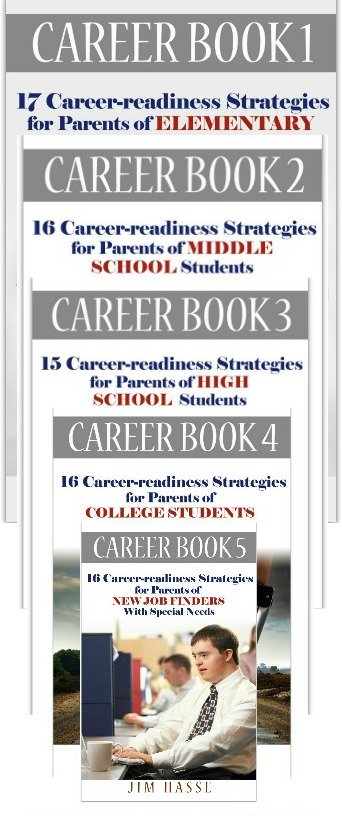Job Application: Cerebral
Palsy
Career Builder for High School Students
By Jim Hasse, ABC, GCDF, Disability Employment Expert
_________________________________________________________
When to disclose disability (on a job application, on a resume, before a job interview etc.) is a key issue you need to discuss with the high school student with cerebral palsy (CP) you’re mentoring.
After all, he or she may soon have opportunities to work part-time during the school year or on summer vacations. This disability disclosure issue can come up as soon as your youngster fills out his or her first job application for that part-time work.
As a career development facilitator, I
tell my clients this: “When to tell prospective employers about your disability
depends on your disability, your job opportunity, your personality and your
prospective employer.”
In other words, this disability disclosure issue goes
far beyond the job application. And there are no easy answers, especially if
your youngster’s CP is largely “hidden.” Yet, every job seeker with a
disability eventually needs to personally come up with a strategy for addressing
this matter.
Remember, under the Americans with Disabilities Act (ADA),
your youngster is not required to disclose his or her CP to an employer,
even though it may just be a mom or pop candy store down the street. And, if
and when your youngster does disclose, he or she is not required to tell everything
about the personal aspects of CP. In other words, once your youngster discloses
CP. a potential employer can only ask for limited information about that
disability.
In any case, when your youngster does disclose his or
her CP, he or she needs to be prepared to provide just the basic information
about limitations and about accommodations needed. That applies to simply completing
a job application as well as performing essential job functions and receiving
equal benefits and privileges as an employee.
Upon request, information about disability can be
confidential. Your youngster’s co-workers do not need to know about his or her
CP or the need for accommodations.
With those guidelines in mind, consider these three potential disclosure strategies, which are largely mutually exclusive. Each option largely stands on its own, has important advantages as well as disadvantages and should be applied only after careful examination of your particular situation and of the potential employment situation.
At
any rate, the options may give you some ideas about how to coach your youngster
in deciding when and how to disclose disability under a variety of employment
circumstances.

Strategy 1: Getting your foot in the door first
Don’t reveal your CP on your job application, resume or cover letter (even if you have gaps in your work experience due to your CP) because it will potentially trigger preconceived, inaccurate notions about disability among the people screening resumes for the open position.
Eliminate achievements or associations on your job
application and resume which may reveal your disability.
Instead, do everything you can to get your foot in
the door for job interviews, and, if your CP is visible, try to put your
interviewers at ease early on in the process, assuring them that you have the
skills to do the job.
Benefit:
You’re more likely to have an even chance of getting
through the initial screening process.
Drawback:
You’re surprising your potential employer or job
interviewers, who, at first, may be so preoccupied by your CP, if it is
visible, that you’ll have a difficult time helping them focus on your
qualifications for the job. And the employer will not be prepared to provide
you with any accommodations you may require at the time of your interview.
Needed Preparation:
Let your confidence and out-going personality shine.
Show you can control an awkward situation. Be prepared to handle a variety of
reactions. Weave your CP into the entire interview, showing how it has prepared
you for meeting the work requirements and helping the company extend its
success.
Strategy 2: Disclosing your
disability as soon as possible
Include a “Personal Statement,” a few paragraphs in length on a separate sheet or document, with your resume. In this statement, briefly describe your CP and explain what adaptive strategies you use to get your work done.
Benefit:
Briefly describing your CP upfront may help your
interviewers become comfortable with you more quickly, giving you more time to emphasize
your skills and attributes (what you can offer instead of what you perhaps need
in terms of accommodation).
You’re informing your potential employer about your CP right off the bat, and, in doing so, you’re putting the focus on how you’re able to do the job. The employer can be prepared for the accommodation you may require at the time of your interview.
Drawback:
For employers who are not truly inclusive and not truly disability friendly, you may be setting yourself up as a job candidate who, in effect, is saying, “Don’t bother considering me for this job. You have plenty of other qualified job candidates without a disability.”
Needed Preparation:
Carefully craft you “Personal Statement” so it not
only describes your CP and accommodation needs but also shows why disability
has helped you acquire the qualities you have discovered, through company
research, that are high on the list of your targeted employer’s needs.
Strategy 3: Positioning your disability as a competitive edge
Instead of selecting an option for when to reveal your CP to a prospective employer (as though your disability always has to be a negative factor), turn the table 180 degrees. Position your disability experience as your competitive edge and target employers who claim to be disability friendly.
Consider what you’ve learned by adapting to (and living well with) your CP as part of your functional experience and link those lessons to the development of your accomplishments and skills.
That will give you ideas about how to develop your personal narrative as a job seeker around your disability experience. Use your personal narrative to drive your entire job marketing campaign (your resume, your offering statement, your portfolio, your company research, your networking and your job interview preparation). It can even drive how you complete a job application.
Benefit:
You’re taking the initiative to show so-called disability friendly employers how your disability-honed experience has strengthened your problem-solving ability, your resiliency and your emotional intelligence -- attributes that are valued by employers and that give you an advantage over other applicants for a specific job.
By doing so, you may discover a golden opportunity in an organization which realizes that hiring people with disabilities is good business.
Drawback:
You’re taking a calculated risk and will probably be rejected or ignored by employers who are not truly inclusive and not truly disability friendly.
Needed Preparation:
Incisive company research is important here. You need to network to find which companies on “disability friendly” lists are really all-inclusive or just there to make a good showing and meet U.S. Equal Employment Opportunity Commission (EEOC) requirements.
You need to know yourself and why your disability experience is relevant to today’s workplace. And, you need to know how to explain the connection between disability experience and workplace success in simple and concrete terms that are meaningful to hiring managers.
Those are the options I believe your high school student with CP faces as he or she struggles with this sometimes-tough disability disclosure issue that crops up as soon as his or her first job application needs to be completed. Which to choose boils down to personal preference and personal situation.
But, here's another wrinkle to this issue.
On March 24, 2014, new rules for Section 503 of the Rehabilitation Act took effect, covering employers who are federal contractors or subcontractors.
The new rules require federal contractors and subcontractors to aspire to, and track progress toward, employing individuals with disabilities.
Called an aspirational goal, covered employers must now attain, or show progress toward attaining, a workforce that consists of at least seven percent of people with disabilities. That new ruling may affect which disclosure strategy your youngster eventually chooses.
So, choosing a course of action with personal capabilities, job, employer and competitors in mind -- and following through with that strategy -- is even more essential to getting hired in today’s part-time job market (and tomorrow’s mainstream workplace).
Return from Job Application to Part-time
Jobs
Go to Cerebral Palsy Career Builders
This is Creative Commons content. You can freely and legally use, share and repurpose it for non-commercial purposes only, provided you attach this sentence and the following attribution to it (including the two links):
Originally written and illustrated by Jim Hasse, ABC, GCDF, owner of Hasse Communication Counseling, LLC, who, as a person with cerebral palsy, served for 10 years as a vice president in a Fortune 500 company during his 29-year career in corporate communication. He’s an Accredited Business Communicator, certified as a Global Career Development Facilitator and author of 14 Amazon books about disability awareness and disability employment issues.





